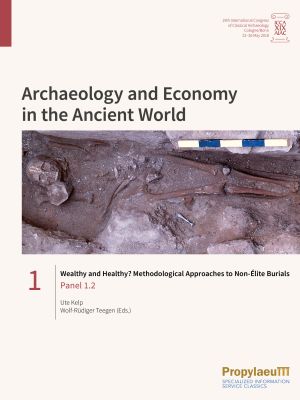Coppa, Alfredo
Bazzano – ein Gräberfeld bei L’Aquila (Abruzzen): Die Bestattungen des 8.-5. Jahrhunderts v. Chr.
Bazzano near L'Aquila is one of the largest pre-Roman burial sites in Apennine Central Italy and even surpasses the necropolises of Fossa and Campovalano in the number of graves.
More than 500 burials of the Orientalising and Archaic period (8th-5th century BC) from the excavations of the Soprintendenza per i Beni Archeologici dell'Abruzzo from 1992-2004 are presented and analysed in this publication for the first time.
Above all, Etruscan pottery imports and their local adaptations enable a finer dating of the graves with their seemingly older traditional Italic decorative elements and weapons within an absolute chronology. In this way, the occupation sequence of the necropolis in four main phases, established on the basis of seriations and grave overlaps, can be better compared with the existing chronology systems.
In addition to questions on burial customs and social structures, the main part of the work is devoted to the classification and chronology of typical Middle Italian objects that are widespread far beyond Bazzano. With the complementary anthropological contributions, the picture of a mobile Iron Age population is sketched, which differed in its lifestyle from the individuals buried in the neighbouring necropolis of Fossa. Possibly this is due to a pronounced pastoral economy, transhumance or a very active warrior class, whose status is also emphasised by the high number of graves containing weapons.
Wealthy and Healthy? Methodological Approaches to Non-Élite Burials: Panel 1.2
The analysis of ancient societies beyond the political system, leading actors, and élite groups relies heavily on the archaeological record. Abundantly preserved burial sites present a major part of ancient testimonies. Yet, neither are burials with their grave goods a mirror of past lives nor do non-élite burials necessarily equal poor burials, and we need a mixture of criteria to identify non-élite as well as non-poor burials. The bones of the deceased are, however, first class bio-historical sources. There is a strong correlation between wealth and health in antiquity and human remains reflect the social status via diet and health.
With respect to various methodological approaches to funerary archaeology linking the capacities of material culture studies to social and natural sciences, the contributions in this volume explore the relationship between material culture, health and social status. They evaluate non-élite burials regarding the social persona and life style of the deceased as much as the ideology of the descendants expressing their beliefs through the burial process. Precisely the focus on context analysis – aiming beyond the funerary sphere – constitutes the importance of the case studies united in this volume.








